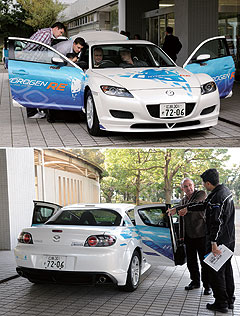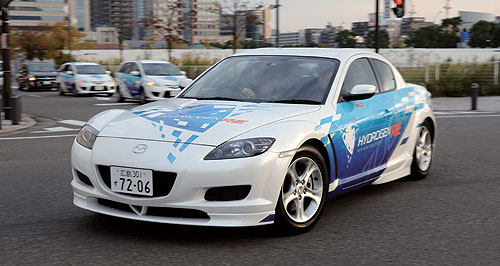Future models - Mazda - RX-8 - Hydrogen HREFirst drive: Hydrotherapy for Mazda’s RX-8Hydro power: Mazda's hydrogen-powered RX-8 HRE prototype is well down on petrol power. We drive Mazda’s environmentally friendly RX-8 Hydrogen RE sportscar27 Oct 2009 IT IS slower, heavier and noisier than its petrol-powered equivalent and cannot be refuelled with hydrogen away from a handful of dedicated filling stations in Japan, Norway and Los Angeles. But as a zero-emissions sportscar with a driving range of up to 650km, the RX-8 Hydrogen RE has few peers. Mazda admits that until a hydrogen refuelling infrastructure exists and the price of crude oil increases significantly, hydrogen-powered cars have no future, but the RX-8 HRE continues to be a rolling demonstration of Mazda’s belief in hydrogen as an alternative for fossil fuel internal combustion engines. First offered for commercial lease in Japan in February 2006, the dual-fuel RX-8 has attracted most interest in Norway, whose government and Mazda has jointly established the Hydrogen Road of Norway (HyNor) project. So far only a handful of HRE RX-8s have been delivered to Norway, which is implementing a 580km hydrogen refuelling network for the main road between Oslo and Stavanger. Mazda plans to ship a total of 30 vehicles to Norway as part of the project.  Based on Japan’s automatic-only right-hand drive RX-8 HRE, Norway’s version is a left-hand drive manual-only proposition, with a few differences. Based on Japan’s automatic-only right-hand drive RX-8 HRE, Norway’s version is a left-hand drive manual-only proposition, with a few differences.While the domestic vehicle delivers similar power and torque outputs to Australia’s RX-8 when running on petrol, outputs shrink from 154kW and 222Nm to just 80kW and 140Nm on hydrogen. Mazda has detuned the petrol-fed outputs to match the performance on hydrogen fuel, eliminating the vast difference in acceleration we experienced in Japan last week when switching between fuel sources. Also, instead of a full-sized petrol tank, the Norwegian RX-8 runs a tiny five-litre job, making petrol very much a back-up fuel for Mazda’s rotary coupe there. A huge 110-litre hydrogen tank fills the entire boot area on both cars, eliminating all luggage space outside the cabin. A total of 16 hydrogen fuel stations exist in Japan (10 in Tokyo), where Mazda let us sample a domestic-specification RX-8 HRE over a 12km public road loop near its Yokohama R&D facility outside Tokyo. Remove the bold ‘Hydrogen RE’ livery and the alternative-fuel RX is almost identical to any other, inside and out. Two external fuel filler flaps (one on the left for petrol, on eon the right for hydrogen), two fuel gauges and a discreet rotor-shaped fuel selector switch near the driver’s right knee are the only giveaways this is no garden-variety RX-8. One member of our party made the mistake of stepping on the accelerator pedal during start-up, rendering his RX-8 HRE inoperable until Mazda engineers applied a quick fix. Otherwise the future-fuelled RX-8s were as well integrated and glitch-free as any series-produced Mazda. Biggest surprise, however, is the hoarse engine note when running on hydrogen. The louder, more gruff induction noise from under the bonnet is inescapable at all speeds, helping to give the impression there’s slightly crisper throttle response from idle, which is slightly higher in hydro mode. But the fact is there’s significantly less performance available from hydrogen, which has a much lower energy density than petrol, and while the 154kW Japanese version is less powerful than Australia’s RX-8 (158kW auto, 170kW manual), the shortfall to the auto-only hydrogen car’s 80kW output is immediately apparent. Push the fuel selector back over to petrol (which happens automatically when the car runs out of hydrogen, but not vice-versa) and the performance improvement is instant. Mazda says the hydrogen hardware adds about 50kg to the vehicle’s kerb weight – not including the weight of the hydrogen itself, which hits the scales at a featherweight 2.7kg – so the RX-8 HRE’s comparably low performance is due mainly to the hydrogen fuel’s lack of zest. Another major drawback is fuel consumption, which is also markedly higher in hydrogen mode, although Mazda provides no specific numbers. Officially, the RX-8 HRE can travel the same 549km as its donor model on petrol, while the bootful of hydrogen extends its range by a further 100km. Of course, fuel economy is primarily dictated by driving style, and while we admit we gave the RX-8 HRE a solid workout, according to the gauge in the version we drove our example burned a whole quarter of a tank of hydrogen over the 12km urban test loop. The price of hydrogen is reasonably comparable with petrol in Japan so, in theory, if you are prepared to refuel more frequently, the RX-8 HRE will not be outrageously more expensive to run than the standard model. Of course, it’s difficult to put a price on zero-emissions motoring, but Toyota’s Prius proves there are a growing number of people willing to pay a premium to reduce fuel consumption and exhaust emissions. But while the Prius is now into its third generation as a production model, the hydrogen RX-8, which emits only steam, remains an expensive hand-built prototype that could be years from factory production. It is impossible to estimate what the RX-8 HRE would cost as a production car without a hydrogen fuel infrastructure to generate demand, but given the extent of its engine and fuel storage modifications, it is unlikely to be double that of the regular RX-8 ($51,440), which is what the Prius costs over similar-sized small cars, including Toyota’s own closely-related Corolla. If Mazda can make the RX-8 HRE a little quieter and more economical for a sensible price, it seems the only thing between the public and a zero-emissions factory sportscar without significant compromise is a hydrogen fuel network.  Read moreAll future models Alfa Romeo Alfa Romeo Abarth Abarth Audi Audi Aston Martin Aston Martin BMW BMW Bentley Bentley Chrysler Chrysler Chevrolet Chevrolet Dodge Dodge Citroen Citroen Ferrari Ferrari DS DS Ford Ford Fiat Fiat FPV FPV Foton Foton Haval Haval Great Wall Great Wall Honda Honda Holden Holden Hyundai Hyundai HSV HSV Isuzu Isuzu Infiniti Infiniti Jeep Jeep Jaguar Jaguar Lamborghini Lamborghini Kia Kia Lexus Lexus Land Rover Land Rover Mazda Mazda Maserati Maserati Mercedes-Benz Mercedes-Benz McLaren McLaren Mini Mini Nissan Nissan Mitsubishi Mitsubishi Peugeot Peugeot Opel Opel Proton Proton Porsche Porsche Renault Renault Ram Ram Saab Saab Rolls-Royce Rolls-Royce Smart Smart Skoda Skoda Subaru Subaru SsangYong SsangYong Tesla Tesla Suzuki Suzuki Toyota Toyota Volvo VolvoMotor industry news |
Click to shareMazda modelsResearch Mazda All future models Alfa Romeo Alfa Romeo Abarth Abarth Audi Audi Aston Martin Aston Martin BMW BMW Bentley Bentley Chrysler Chrysler Chevrolet Chevrolet Dodge Dodge Citroen Citroen Ferrari Ferrari DS DS Ford Ford Fiat Fiat FPV FPV Foton Foton Haval Haval Great Wall Great Wall Honda Honda Holden Holden Hyundai Hyundai HSV HSV Isuzu Isuzu Infiniti Infiniti Jeep Jeep Jaguar Jaguar Lamborghini Lamborghini Kia Kia Lexus Lexus Land Rover Land Rover Mazda Mazda Maserati Maserati Mercedes-Benz Mercedes-Benz McLaren McLaren Mini Mini Nissan Nissan Mitsubishi Mitsubishi Peugeot Peugeot Opel Opel Proton Proton Porsche Porsche Renault Renault Ram Ram Saab Saab Rolls-Royce Rolls-Royce Smart Smart Skoda Skoda Subaru Subaru SsangYong SsangYong Tesla Tesla Suzuki Suzuki Toyota Toyota Volvo VolvoMotor industry news |















Facebook Twitter Instagram